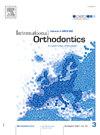Efficacy of single versus double miniscrew-assisted maxillary anterior intrusion in subjects with gummy smile or deep bite: A systematic review and meta-analysis
IF 1.9
Q2 DENTISTRY, ORAL SURGERY & MEDICINE
引用次数: 0
Abstract
Aim
The focus of this review is to compare the efficacy and predictability of single versus double miniscrew placement for maxillary anterior intrusion.
Material and methods
Systematic search for relevant articles published between 2005 and January 2025 was conducted across electronic databases including Scopus, PubMed, WoS, EBSCOhost and Cochrane Library. Studies meeting pre-defined eligibility criteria were included and assessed for methodological quality. Data on intrusion of maxillary anteriors using MS was extracted from included studies. Meta-analysis was conducted to evaluate the effectiveness of single versus double MS in relation to anterior intrusion.
Results
The analysis showed that bilateral miniscrews (MS), placed between the maxillary lateral incisors and canines, resulted in significantly greater maxillary anterior intrusion compared to a single MS placed between the central incisors. Bilateral MS also provided better control over incisor inclination and stability with minimal side effects. The forest plot further confirmed significant intrusion with bilateral MS, with a mean difference of −0.25 and an overall effect (Z) of 1.98. The comparison between single and double MS demonstrated a significant effect of double MS on maxillary anterior intrusion (P < 0.00001).
Conclusion
Bilateral MS configurations offer a reliable and effective treatment approach in maxillary anterior intrusion, particularly when considering individual variations in anatomical and clinical factors.
单支与双支微型牙套辅助上颌前牙压入治疗粘笑或深咬的疗效:系统回顾和荟萃分析
目的本综述的重点是比较单颗与双颗微型牙套置入治疗上颌前牙嵌顿的疗效和可预测性。材料与方法在Scopus、PubMed、WoS、EBSCOhost和Cochrane Library等电子数据库中系统检索2005年至2025年1月间发表的相关文章。纳入了符合预定资格标准的研究,并对方法学质量进行了评估。从纳入的研究中提取MS对上颌前牙侵入的数据。我们进行了荟萃分析来评估单质谱与双质谱治疗前路侵入的有效性。结果分析表明,在上颌侧切牙与犬齿之间放置双侧微牙钉(MS),与在中切牙之间放置单侧微牙钉相比,上颌前突明显增大。双侧MS还可以更好地控制门牙倾斜和稳定性,副作用最小。森林样地进一步证实了双侧MS的显著入侵,平均差值为−0.25,总体效应(Z)为1.98。双MS与单MS的比较表明双MS对上颌前压的影响显著(P <;0.00001)。结论双侧MS配置是治疗上颌前压的可靠有效的方法,特别是考虑到个体解剖和临床因素的差异。
本文章由计算机程序翻译,如有差异,请以英文原文为准。
求助全文
约1分钟内获得全文
求助全文
来源期刊

International Orthodontics
DENTISTRY, ORAL SURGERY & MEDICINE-
CiteScore
2.50
自引率
13.30%
发文量
71
审稿时长
26 days
期刊介绍:
Une revue de référence dans le domaine de orthodontie et des disciplines frontières Your reference in dentofacial orthopedics International Orthodontics adresse aux orthodontistes, aux dentistes, aux stomatologistes, aux chirurgiens maxillo-faciaux et aux plasticiens de la face, ainsi quà leurs assistant(e)s. International Orthodontics is addressed to orthodontists, dentists, stomatologists, maxillofacial surgeons and facial plastic surgeons, as well as their assistants.
 求助内容:
求助内容: 应助结果提醒方式:
应助结果提醒方式:


